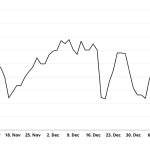Back in 1965, when millions of Americans were tuning in to TV comedies like Gilligan’s Island, I Dream of Jeannie, and Get Smart, almost no one was paying attention to the drama unfolding in the bond market. The yield curve was in the process of “inverting,” which meant that a recession loomed.
Prior to that moment in history, a recession always followed an inverted yield curve. This indicator was infallible… until it wasn’t. The steep yield curve inversion of 1965 did not lead to a recession in 1966. In fact, U.S. GDP soared more than 6% that year.
Despite that one notable exception, however, every other yield curve inversion of the last 70 years has correctly signaled the onset of recessionary conditions. Not surprisingly, most economists still imbue the yield curve with mystical predictive powers.
If an inversion takes place, they believe, a recession is (almost) inevitable.
Today, because the yield curve has inverted once again, many economists and investors are fretting about the “inevitable” recession that lies ahead.
You may have seen hysterical headlines about an upcoming economic downturn. Here are a few headlines just from the past week:
But in 1966, that recession failed to materialize, and I believe history will repeat itself again.
First, let’s talk about the inverted yield curve and what it means for the markets and economy. Then, we’ll discuss the initiatives keeping businesses and the overall economic outlook positive… and profitable.
How the 0.1% Generate Huge Income
How do the 0.1% generate huge income? It’s not dividends, bonds, or options — it’s a little-known technique for turning ordinary stocks into massive cash-generating machines. Wall Street “One Percenter” Louis Navellier is detailing this technique in his latest video.
On Trend: The Yield Curve
An inverted yield curve refers to a structure in the credit markets when short-term interest rates rise above long-term interest rates. Historically, this phenomenon anticipates, or “predicts,” a coming recession. It reflects investors’ expectation for longer-term interest rates to continue to decline and is typically associated with recession.
According to research from the Federal Reserve Bank of San Francisco, an inverted yield curve has preceded every recession in the U.S. since 1950, with 1966 being the only false positive (a yield curve inversion that did not lead to a recession).
History Doesn’t Repeat, But it Rhymes
A few notable economic trends from that era provide some insight: Government spending, consumer spending, business investment, and foreign investment were all robust.
Typically, during a recession all or most of these investment activities decline. But in 1966, they did not, due to a few factors:
- The Vietnam War ramped up government spending and helped stimulate the economy;
- Low unemployment rates and a relatively strong economy meant strong consumer spending;
- Business investment remained strong;
- And foreign direct investment continued to flow into the economy.
Fast forward to now, and Eric says economic conditions are nearly identical:
Here’s what has happened since the end of 2020…
- U.S. government consumption spending has climbed 13%…
- Business formations (52-week average) have jumped 16%…
- Foreign direct investment has increased by more than half a trillion dollars – or 11%…
- Private domestic investment has doubled…
- And the U.S. economy has added 13 million jobs, net – a 9% increase.
Be Part of the American Renaissance
As we watch more and more factories – namely those in the EV sector – crop up, especially in the southeast U.S., many semiconductor manufacturers are spending tens of billions of dollars on new foundries in the U.S. Massive initiatives like these are allowing business investment and the employment rate to remain strong.
Analysts are also watching the explosion of artificial intelligence making inroads into all sectors. I recently visited OpenAI’s headquarters, the place where the AI craze started back in November 2022. That’s when ChatGPT, OpenAI’s chatbot became an overnight global sensation.
Even though ChatGPT launched less than six months ago, it has already captured more than 100 million users.
For perspective, it took Facebook four years to gain 100 million users! And it took Netflix an entire decade to reach that milestone.
Consumers have adopted ChatGPT 42 times faster than they adopted the internet. Think about how insane that is. Just a few months after its release, ChatGPT became the fastest-growing consumer software application in history.
What do you think is going to happen with AI stocks? You don’t need any artificial intelligence to figure that out.
We’re about to see a massive boom in AI stocks, just like we did in the 1990s with internet stocks… but there’s one major difference…
I believe the gains will be much BIGGER… And it will happen much FASTER.
So fast, in fact, that it could leave some investors behind. This is a time to seize the moment by exploring the vast opportunities artificial intelligence is introducing to the world.
This story may have begun in OpenAI’s headquarters, but it has not even completed the first chapter.
From health care to manufacturing, the sky’s the limit for AI applications. But you’ll have to act fast because those who take advantage of this revolution stand to grow their wealth almost as fast as they can say, “ChatGPT.”
Here’s how to seize the opportunity while you can… and get my #1 stock pick in the space.





